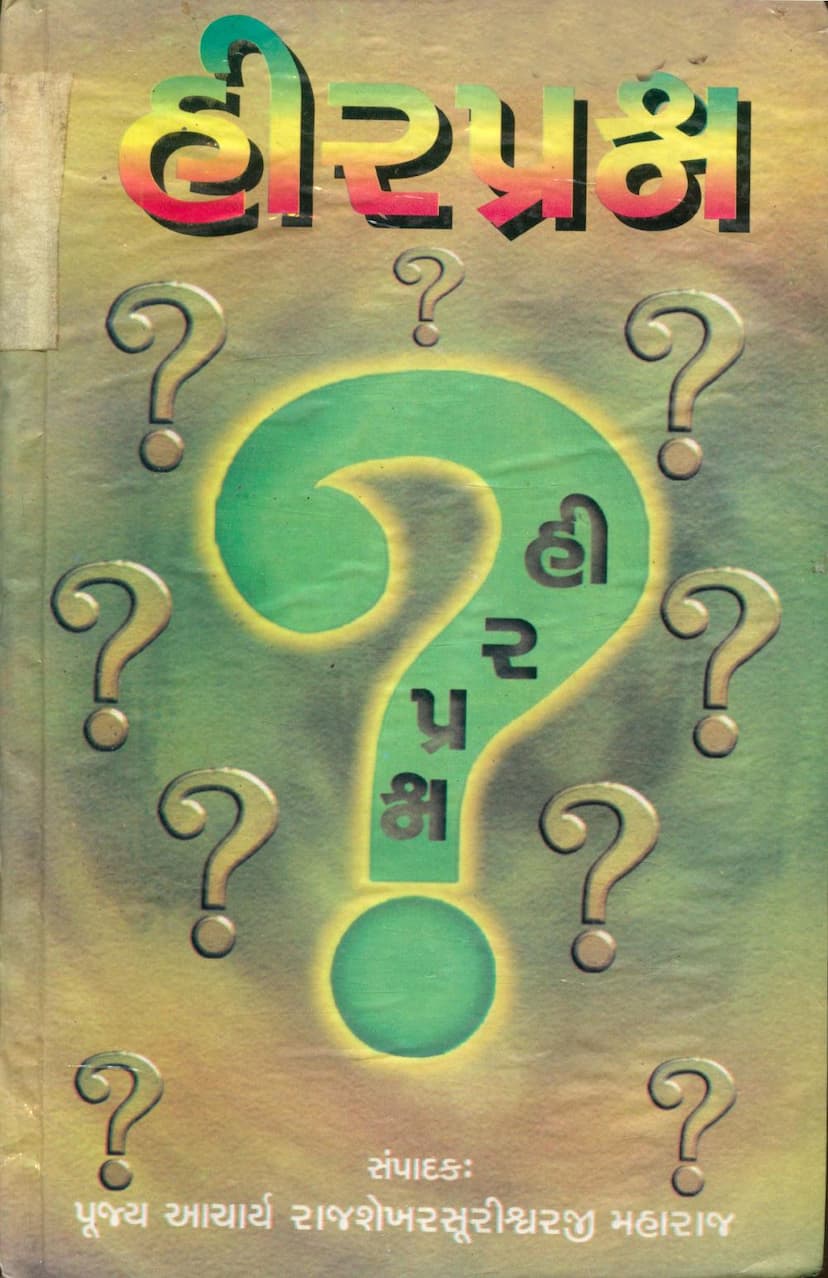Hir Prashna
Added to library: September 1, 2025

Summary
This is a comprehensive summary of the Jain text "Hir Prashna" (also referred to as "Prashnottar Samuchchay" or "Hariprashna") authored by Acharya Rajshekharsuri, compiled by Nyayavisharad Mahopadhyaya Shri Kirtivijay Ganivar, and published by Arihant Aradhak Trust.
Overall Purpose and Content:
"Hir Prashna" is a question-and-answer compendium that addresses a vast array of topics related to Jain philosophy, practices, conduct, history, and scriptures. It features questions posed by learned monks, scholars, and the Jain Sangh, along with detailed, scripturally-based answers provided by the esteemed gurus. The text serves as a valuable guide for understanding intricate Jain principles and resolving common doubts.
Key Aspects and Themes:
The book is structured into four "Prakash" (sections), containing a total of 306 questions and answers. The questions cover a wide spectrum of Jain knowledge, including:
- Monastic and Lay Conduct (Sadhu and Shravak Dharma): This is a major focus, with numerous questions about the proper conduct, duties, virtues, and potential transgressions of monks and nuns, as well as the rules and observances for householders (shravaks and shravikas). This includes discussions on their venerability, specific practices, and interpretations of scriptures.
- Scriptural Interpretation: The text delves into the meaning and application of various Jain Agamas and other significant scriptures, clarifying complex doctrines, historical accounts, and philosophical concepts.
- Historical and Biographical Information: It touches upon the lives and teachings of important Jain Acharyas and figures, such as Acharya Vijay HeerSuri, who is central to the compilation of this work, and his interactions with historical figures like Emperor Akbar.
- Rituals and Practices: Questions address the details of various rituals, observances, and practices, including fasting (e.g., Ayambil), daily practices (e.g., Pratikraman, Chaitya Vandan), and the observance of specific days and festivals.
- Sects and Doctrines: The text engages with questions concerning the distinctions and relationships between different Jain sects (e.g., Tapagachchha, Khartara, Digambara, etc.), addressing points of contention and clarifying their respective doctrines.
- Cosmology and Karma: It explores concepts related to the Jain universe, the workings of karma, and the cycle of birth and rebirth.
- Practical Dilemmas: The book tackles practical questions that arise in daily life and religious practice, providing scriptural guidance for their resolution.
- Linguistic and Terminological Clarifications: Some questions aim to clarify the meaning of specific terms, verses, or phrases found in Jain scriptures.
Editorial and Publishing Information:
- Editor: Acharya Rajshekharsuri Maharaj.
- Compiler: Nyayavisharad Mahopadhyaya Shri Kirtivijay Ganivar.
- Publisher: Arihant Aradhak Trust.
- New Edition Features: The current publication (reprint) boasts several improvements over its previous edition (published in 1999 VS by Shri Muktabai Gyan Mandir, Dabhoi), including:
- Parallel presentation of Sanskrit text and Gujarati translation for ease of study.
- Inclusion of three numbering systems: Prakash number, Prashna number, and sequential question number.
- Refinement of sentence structure for better clarity.
- Replacement of some archaic wordings with contemporary equivalents.
- Grammatical corrections, including vowel length adjustments.
- Correction of translation errors where identified.
Significance of Acharya Vijay HeerSuri:
The text highlights the profound influence of Acharya Vijay HeerSuri. He was a prolific scholar and a significant figure in Jainism, known for his deep scriptural knowledge and his ability to resolve complex queries. The compilation of "Hir Prashna" is attributed to his teachings and answers to various questions posed to him. His life story, including his birth, spiritual upbringing, scholarly pursuits, and his renowned interactions with Emperor Akbar (leading to the title "Jagadguru"), is detailed in the introductory sections, underscoring his importance and legacy.
Key Philosophical and Practical Discussions:
- Veneration of Monks: The text discusses the conditions under which monks are considered worthy of veneration, even if they possess minor flaws, contrasting it with the unvenerable nature of those who err significantly.
- Inter-Sect Relations: It addresses how to interact with and support individuals from different Jain traditions, offering guidance on giving and receiving spiritual knowledge and support.
- Authenticity of Practices: The book engages in debates on practices like tithe observance, distinguishing between scripturally sanctioned practices and those that may be based on custom or misinterpretation.
- The Nature of Attachment and Detachment: It explores the nuances of attachment and detachment, particularly in the context of monastic vows and householder practices.
- The Role of Causes in Karma: The text clarifies that actions, even if technically in line with rules, can lead to negative karmic consequences if performed with wrong intentions or motives.
In essence, "Hir Prashna" stands as a testament to the rich intellectual and spiritual tradition of Jainism, providing detailed answers to a wide range of questions, thereby illuminating the path for spiritual aspirants and scholars alike.